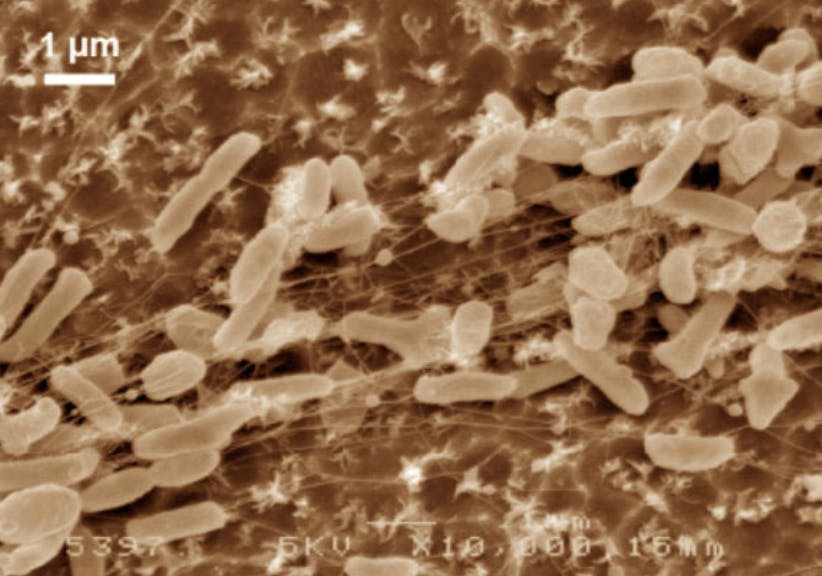Plastic-Eating Bacteria: A Phenomenal Resolution
By Aya Khalaf
February 16, 2022 · 4 minute read
Biology
Earth Science
Environmental Science
Everyone knows the issue with pollution of all kinds, littering, dirty sewage flowing to the ocean and many more human-produced problems. Now you may assume that this must be another argumentative topic about the issues our world suffers from but that’s completely untrue. Consider this article as an introduction to new possibilities and innovations that can contribute to our evolution and save humanity from problems they’re creating. Two words: Ideonella sakaiensis. Ideonella sakaiensis is one of the latest phenomena discovered. It is essentially a plastic-eating bacteria.
Highlighting on the main issue: plastic pollution
As we all know, plastic pollution is one of the biggest burdens our environment suffers from. As a definition, plastic pollution is littering our oceans. If this issue doesn’t get tackled, its consequences will be tragic. Plastic pollution can lead to the death and extinction of many living things, while simultaneously ending marine life which is one of the main necessities of Earth. Humans also need marine life in many ways. To this day, many sea animals are falling ill and dying due to the deadly environment mankind has surrounded them in.
Microplastics play a major role in this kind of pollution. This substance comes from degradation and dissociation of larger plastic objects with time. Moreover, 80% of microplastics come from bottles and bags. In 2014, an estimated 15 to 51 trillion microplastic particles were floating in the world’s oceans, weighing between 93,000 and 236,000 tonnes.
How the plastic-eating bacteria was discovered
Till now, mankind has only found fungi which seemed to be environmentally friendly and beneficial but no bacteria has seemed to pursue that. Until 2016, where a Japanese science team led by Dr Kohei Oda from the Kyoto Institute of Technology and Dr. Kenji Miyamoto from Keio University, collected 250 samples of PET debris from a certain plastic bottles-making factory. Side note that PET is condensed polymer used in certain plastic objects, mainly water bottles, it is highly resistant to biodegradation.
The science team then screened the bacterial candidates (from a bottle recycling plant) to observe the ones feeding on PET. They identified Ideonella sakaiensis 201-F6, which could nearly completely degrade a thin film of PET after six weeks at a temperature of 86 degrees Fahrenheit (30 degrees Celsius). “By screening natural microbial communities exposed to PET in the environment, we isolated a novel bacterium, Ideonella sakaiensis 201-F6, that is able to use PET as its major energy and carbon source,” the scientists explained.

In other words, the bacterium had the phenomenal ability to degrade PET and use it to provide carbon for energy. Briefly, it works by secreting an enzyme (a type of protein that can speed up chemical reactions) known as PETase. This enzyme splits certain chemical bonds (esters) in PET, leaving smaller molecules that the bacteria can absorb, using the carbon in them as a food and energy source.
As for now, it is widely believed by researchers that other bacterial enzymes usually work slowly to digest PET, unlike Ideonella Sakaiensis which proved to be constantly evolving specifically for this job.This statements provides more hopes in performing certain modifications on the enzyme which can really be the new resolution for the pollution issue.
As a result, several teams have been trying to understand exactly how PETase works by studying its structure. Too much research has been done and multiple papers have been published. One relevant paper, however, shows that the part of the PETase protein that performs the chemical digestion is physically tailored to bind to PET surfaces and works at 30°C, making it suitable for recycling in bioreactors. Research also showed that by subtly changing the enzyme’s chemical properties so it interacted with PET differently made it work more quickly than the natural PETase.
Here is a video that shows a glimpse of what scientists have been recently up to concerning figuring out how PETase can be used to save the environment:
The improvements to the PETase activity were not dramatic, and we are nowhere near a solution to our plastic crisis. But this research helps us understand how this promising enzyme breaks down PET and hints at how we could make it work faster by manipulating its active parts. Moreover, this bacterium opens new dimensions of possibilities and hope that there could be other organisms out there that can really take good part in saving our planet from destruction and extinction.
Do you think Ideonella sakaiensis PETase can really contribute as a resolution to the plastic pollution crisis? Share your thoughts in the comments section below!
Sources:
https://www.diamond.ac.uk/Home/News/LatestNews/2020/29-09-20.html
https://theconversation.com/how-plastic-eating-bacteria-actually-work-a-chemist-explains-95233
https://mir-s3-cdn-cf.behance.net/project_modules/1400/0378db101983229.5f2bd9ae94022.jpg
Did you enjoy this article?
About The Author
Aya is a high school rising-senior. She is a huge bookworm, spends too much money on books and is basically a school nerd. Contact her at aya@sciteens.org for article suggestions and book recommendations.